Bereichsnavigation
3. Musical examples illustrative of unequal temperament derived from Part I of "Das wohl temperirte Clavier", played on a modern piano
The following examples are from 14 of the 24 preludes in Part I of Das wohl temperirte Clavier. Nearly all of them (the exceptions are indicated) were recorded on two Bösendorfer grand pianos brought to the Institute for a lecture on this topic in October 2009: (1) an "Imperial" model tuned in the following unequal temperament:
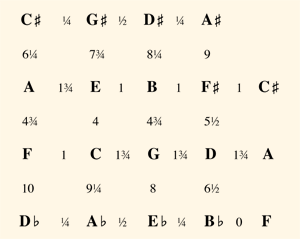
— and (2) a smaller model tuned in equal temperament. All the examples that are not tagged as being played in equal temperament are played in the unequal one.
Whenever I mention that a note in the unequal temperament is tuned relatively high or relatively low in relation to the note a major 3rd below it, I mean implicitly that it is also tuned relatively high or low to the note a major 6th below.
If you are using a Mac computer and if "Safari" (the Mac browser) doesn’t enable you to play the tracks, please use another browser. On certain kinds of non-Mac computers, this or that browser may cause such a problem or else you may perhaps have to click (on the little triangular white-on-red "play"-sign) with the right part of the mouse and then, in a little window which pops up, click on "Play/Pause". Please use high-quality speakers or earphones.
The G-major prelude
Let us begin (as in the musical part of the lecture) with some very subtle distinctions. The leading-tone, F♯, is tuned slightly higher in relation to D and G than is B in relation to G and C, but meanwhile E, in the second half of Bar 1, is tuned slightly lower vis a vis C; so, when F♯ is heard in Bar 2 it sounds slightly and pleasantly "salted":
Track 01: Bars 1-2 (click to play).

Let us hear these nuances in block chords:

When we go on to the next few bars, the fact that C♯, the leading tone to the Dominant, is tuned slightly higher in relation to A and D than is F♯ in relation to D and G is significant. Such a C♯ is well suited to the music because it augments nicely the sense of "lift" in the harmony at Bar 3:

Track 04: Bars 1-4 (plus a dyad).
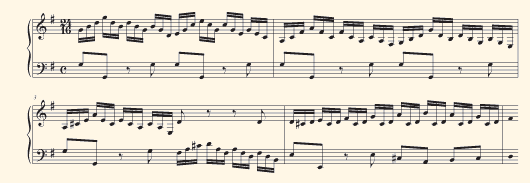
When I transpose down a whole-tone to F-major, the corresponding nuances differ; the leading-tone, E, sounds dull (vis a vis the way F♯ sounded when the music was played in the key that Bach composed it in), and then B, the leading-tone to the Dominant of F, is tuned no higher in relation to G than was A in relation to F:
Track 05: The first 4 bars (plus a dyad) transposed down to F-major.
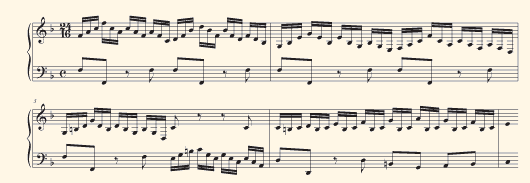
Here is the comparison in terms of block chords – and notice how the first set of chords implies a suitably trochaic macrorhythm (i.e. with the first half of each bar bearing a more stress than the second half) better than does the second set (i.e. the set transposed down a whole-tone):
Track 06: Two sets of six chords.
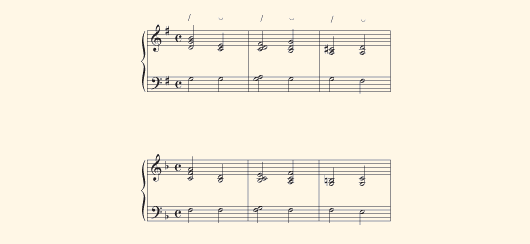
If you agree that it is a virtue for the F♯ in Bar 2 to be "spiced" subtly more than the B and E in Bar 1, and then for the C♯ in Bar 3 to be spiced again slightly more (i.e. more than F♯), then you may also find it felicitous (as I do) for G♯ in Bar 6 to be spiced a bit more, and D♯ in Bars 8-9 yet more and then to have a tapering off of these effects as the music reverts to C♯ in Bar 10 and F♯ in Bar 11:
Track 07: The first 12 1/4 bars.
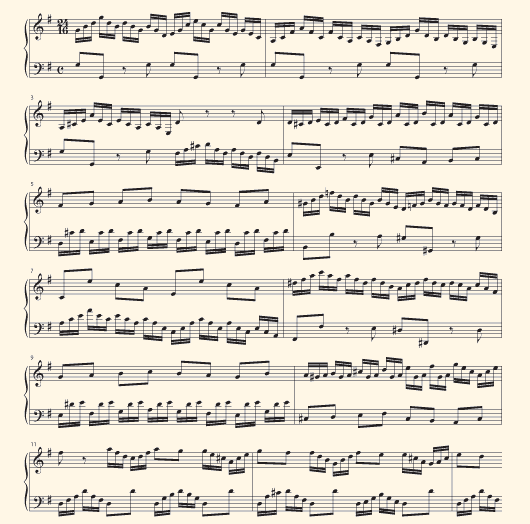
This aspect of the way in which the nuances of the tuning are related to the harmonic structure of the piece is reflected in the fact that nearly all the semitones and major 3rds in the music are represented in the right halves of the following diagrams:
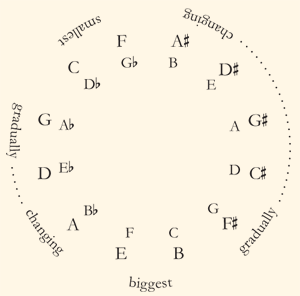
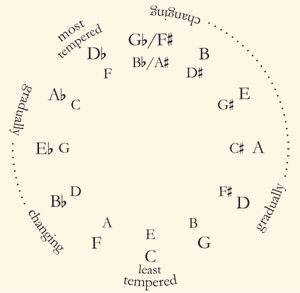
My rubatos etc. may have been exaggerated, and maybe the piece should be played piu mosso; but still I think that to play it truly veloce in this kind of temperament is to waste the nuances of what I consider to have been Bach's preferred style of harpsichord tuning when he composed it:
Track 08: The first five bars or so, played veloce.
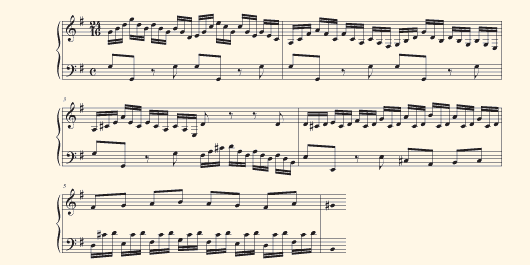
Such playing misconstrues the genre. This was originally intimate music, played by Bach for only one or two students at a time. The music at this fast tempo is just as comely in equal temperament as in the unequal one:
Track 09: The first five bars or so rendered in equal temperament by a midi-synthesizer.
Please go back now and listen again to Tracks 1–7 before we go on to consider whether, since at a moderate tempo the piece sounds a little better in G-major than in F, it might sound even better in A than in G.
In the tracks comparing between the music as composed in G and as transposed down to F, the interesting differences began to occur in Bars 2 and 3. There was no difference of nuance within the first half of Bar 1:
Track 10: The first half-bar in G, and then transposed down to F; and then the first bar in G.
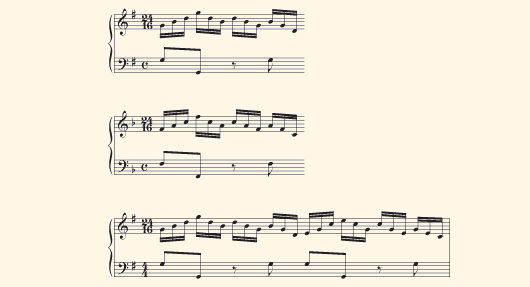
But now let us add A-major to the comparison:
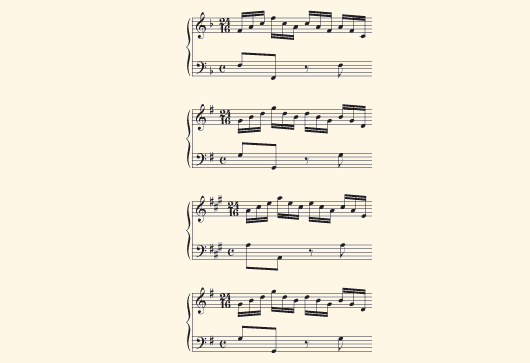
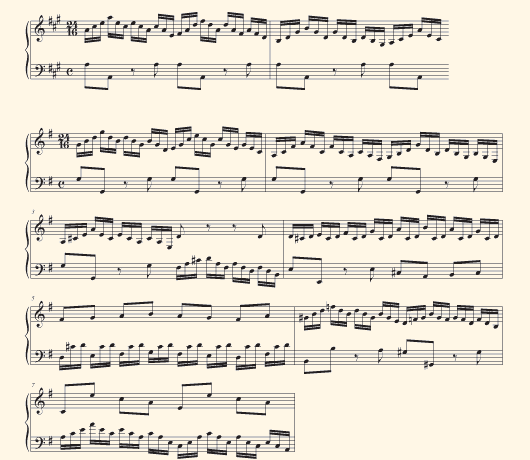
In the A-major transposition, C♯ sounds nervous in the first bar of this piece as it beats intermittently (distinctly more than six times per second) with A and E.
(My statements as to how fast certain intervals are beating are based on assuming that concert A is at 440HZ. If it were a semitone lower, then the beats for each interval would be about 6% slower.)
The average of the amounts of tempering for all the major 3rds has to be the equal-temperament amount (7 schismas), and the amount for A-C♯ should be just a little less than that average. (In the diagram near the beginning of this Webpage the amount assigned to it is slightly more than 6 schismas.) However, in equal temperament the analogous amounts would be identical (at 7 schismas) for A-C♯, G-B and F-A, and therefore the initial chord of this piece would have nearly the same nervously intermittent quality regardless of whether it were played in G-, A- or even F-major:
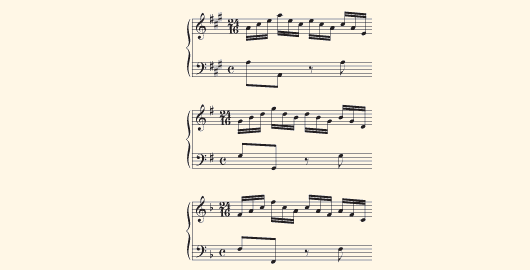
— whereas in the unequal temperament, B in the initial G-major chord is easy-going, and then the successively more sprightly qualities of F♯ in Bar 2 and C♯ in Bar 3 are a blessing:
Track 13: Bars 1-4 plus a dyad.
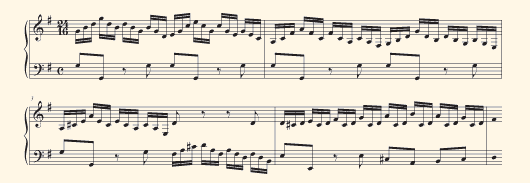
Yet I would not say that given equal temperament, one might just as well render the music as in Track 8. First-class dynamics and timing will make their good effect even if the style of the tuning is insipid in relation to the music.
The A-major prelude
The same C♯ that sounded uncomfortably nervous in the first bar of the G-major prelude when it was transposed up a whole-tone sounds perfectly OK in this inherently more sciolto kind of music. Here is the very beginning:

Notice also how appropriate to this piece are the nuanced temperings of G♯, tuned as it is a little higher vis a vis E than it would be in equal temperament, and of D♯, which is distinctly higher than it would be in equal temperament:
Track 15: The first 5 1/2 bars plus a dyad.
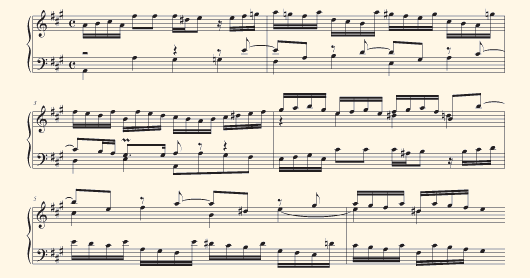
When the music is transposed down a whole-tone to G, the resulting B in Bar 1 sounds slightly tepid (as if the player were dull!):
Track 16: The beginning in A, then transposed down to G, then again in A.
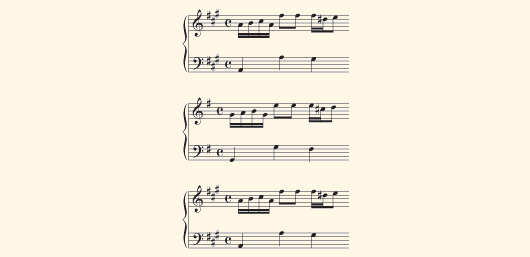
And the same is true (when the music is transposed thus a whole-tone down) of the F♯ in Bar 2:
Track 17: The first 2 bars (plus a dyad) transposed down a whole-tone to G.

The sprightliness of the corresponding G♯ in the original key is more appropriate to the context:
Track 18: The first 5 1/2 bars (plus a dyad).
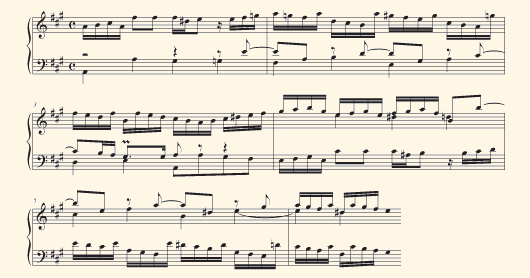
If the piece sounds thus better in A-major than in G, would it sound even better in B than in A?
Track 19: The first 3 1/4 bars transposed up a whole tone to B-major.
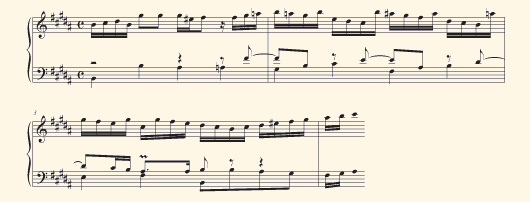
No, the nuances in the original key are the right ones, with neither too much nor too little "spice."
The B-major prelude
The same D♯ and A♯ that sounded uncomfortably high in the A-major prelude when it was transposed up a whole-tone sound appropriately expressive in this quite tender music:
Track 20: The first 5 bars plus a dyad.
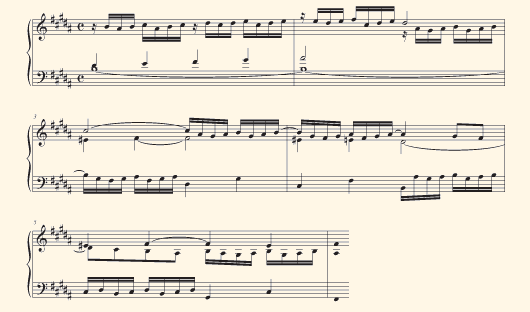
Not only the remarkably high tempering of A♯ but also the even higher tempering of E♯ is OK here. And, the player can, because of the rather high tempering of the D♯ at the outset, treat that note effectively as if it were an appoggiatura to the following E (instead of treating it as a stable consonant note and the E as a dull passing-note). This nice but "ungrammatical" treatment of the D♯ is aesthetically compatible with treating the A♯ at Bar 2 and the first three E♯'s as accented neighbor- or passing-notes:
The kind of playing which these nuances prompt one to adopt is appropriate also in equal temperament even though the result in that tuning is not quite as expressive:
Track 22: The same five bars in equal temperament.
When the music is transposed up a semitone to C-major, the appoggiatura at Bar 2 loses some of its edge (in the unequal temperament):
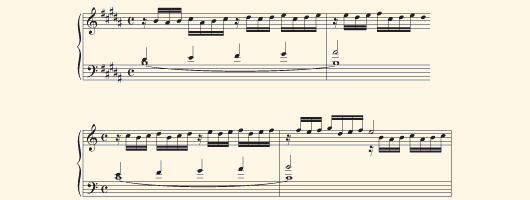
And, the Dominant at Bar 5 sounds almost ecclesiastical when the piece is transposed up to C-major, but properly expressive when the notes are those which Bach composed:
Track 24: Bars 1–5 (plus a dyad) transposed up a semitone, and then again but not transposed.
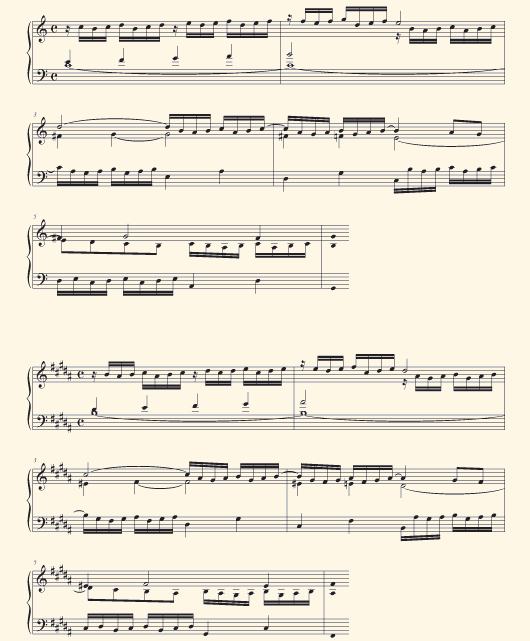
The last chord of the piece is in an unusual disposition. If it had included middle D♯ as well as the B just below middle C, then the beating of that major 3rd would have been intermittent (at nearly 11 per second), whereas the beating of the major 3rd an octave lower, at about 5 1/2 per second, is just shy of intermittence and is thus more like a lively vibrato:

Observe the difference between that nicely expressive beating (i.e. nice for the last chord of this piece) and the more laid-back beating, at 3 per second, of the major 3rd a semitone higher, C-E:
Track 26: The major 3rd between tenor's low C and E, and then the one a semitone lower.

In large part because of this difference (yet also because the leading-tone is more expressive in B- than in C-major) it seems to me that the ending of the piece is more satisfying in B-major than when it is transposed up a semitone to C:
Track 27: The last 2 bars in B and then transposed up a semitone to C.
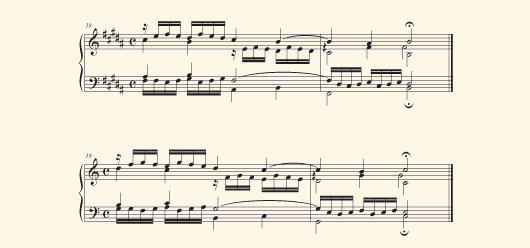
In this musical context, that particular chord in C-major makes a curiously insipid effect, doesn't it? Here is the same comparison the other way around:
Track 28: The last two bars transposed up to C-major, and then in the original key of B-major.
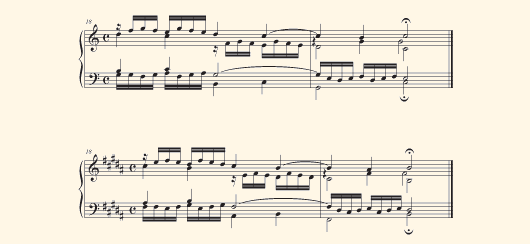
The C-major prelude
The remarkably moderate (but not altogether dull) tempering of C-E is just right for the beginning of this piece:
Track 29: The first 1 1/4 bars.

In this context of moderate tempering, the "slightly salted" quality of F♯ is a benefit in bars 6 and 10:
Track 30: The chords that are (in Bach's composition) arpeggiated in Bars 1-11.

Here is the first of those chords and then the last four of them, played in equal temperament:
Track 31: In equal temperament, the chords which are arpeggiated in Bars 1 and 8-11.

In the last of those chords, the beating in equal temperament of the major 10th, G-B, at about 7 3/4 per second makes an intermittent effect, whereas in the unequal temperament the effect of the beating at less than 5 1/2 per second is not noxious:
Track 32: The same chords in the unequal temperament.
Also rather stark is the comparison between C- and D♭-major in the unequal temperament. Here it is for the beginning of the piece:
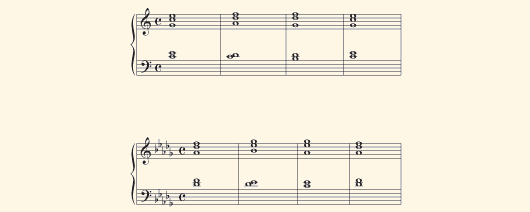
And here it is for the end:
Track 34: The last two bars in C-major and then transposed up to D♭.
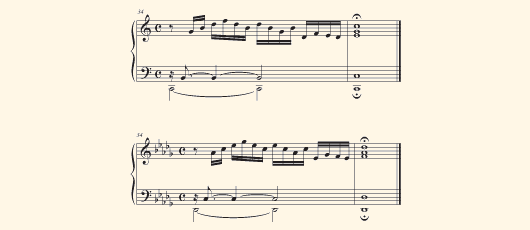
The difference between melodically sweet and sour major 3rds is perhaps even more salient here than the different qualities of their beating as harmonic intervals.
The C♯-major prelude
The same E♯ and B♯ that were too piquant in the previous track are OK in this sprightly piece:

The extreme sharps sound more appropriate in this music than do the corresponding naturals when the music is transposed down a semitone to C-major:
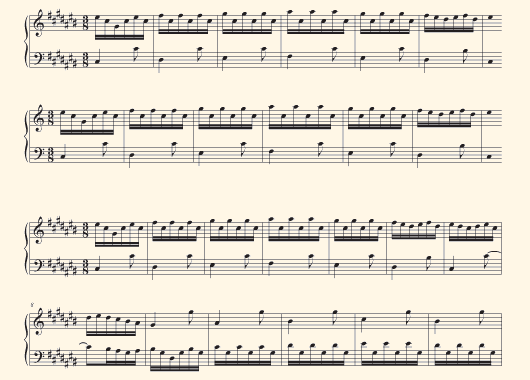
In the moderately tempered key of D-major, the theme could perfectly well be simplified to the following melodically straightforward version:

In a preliminary draft of the piece he was even more cautious than in the final version about the use of E# in the first bar:
Track 38: The first 6 bars (plus one dyad) of an earlier draft.

The piquant effect of the E♯ was here minimized at the outset, but at the cost of making the right-hand part sound, in my opinion, a little too "artificial" melodically for a piece of this overall character.
When played in equal temperament, the first bar sounds equally OK (though not remarkably scintillating) in C-, C♯- or D-major:
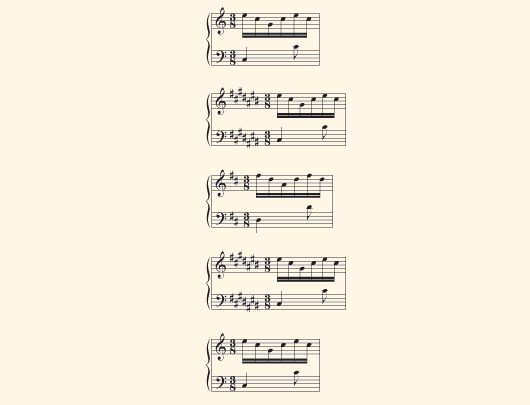
The last chord of this piece is notable in somewhat the same way as that of the B-major prelude, inasmuch as the only major 3rd is in the low-tenor range. On the harpsichord, full chords mean forte playing. Here at the end of the C♯-major prelude, the thickness of the chords is complemented by the intermittent beating (at 8 per second) of the major 3rd:

If these bars are transposed down a semitone, the concluding C-major triad seems banal to me (mainly because the major 3rd, beating 3 times per second, sounds insufficiently aggressive for this particular musical context):
Track 41: The last 8 bars transposed down a semitone to C-major.

Here is the comparison more succinctly put:
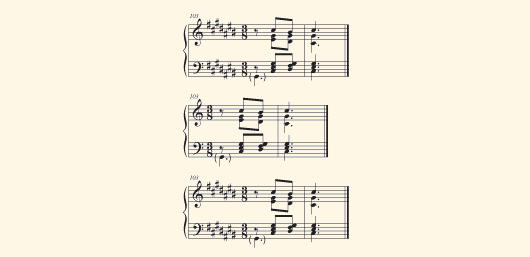
You may recall that I said, when discussing the G-major prelude, that the entire set of pieces in The well-tempered clavier belongs to an intimate genre and that Bach played them for just one or two students at a time. I would reconcile that premise with the robust quality of the music at the end of the C♯-major prelude (and indeed in many other places in the set) by saying that very often one genre will imitate or evoke another. (But of course the big chords at the end of this prelude shouldn't be played like, say, the ones at the beginning of the Grieg concerto.)
The F♯-major prelude
This is an unusual piece in that the right-hand part is full of syncopations and clever echappes and cambiatas. The nervous effect of the notably high tempering of A♯ and E♯ can be exploited to foster a sense of delicate frolic which the music is (in my opinion) obviously intended to convey:
Track 43: To the beginning of Bar 7.
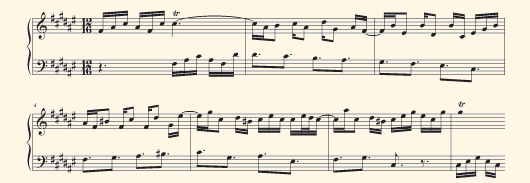
The opening motif sounds inherently a little less scintillating when transposed down or up a semitone than when played in the intended key of F♯:
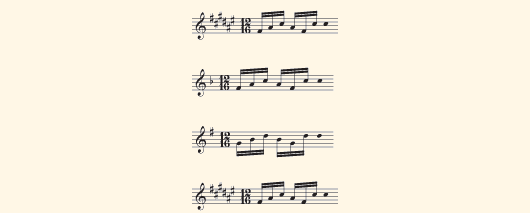
Try as I might to play the first few bars expressively in F-major, some of the notes that ought to shimmer sound pale and tentative instead:
Track 45: Bars 1–6 (plus a note) transposed down a semitone.
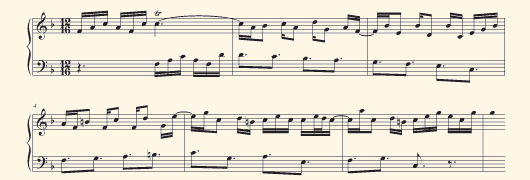
The originally intended nuances of tuning give the notes the right qualities:
Track 46: Bars 1–10 plus a dyad.
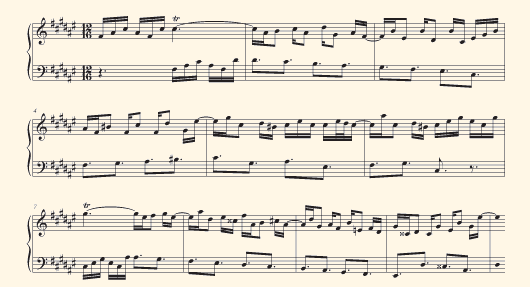
If you find the rubatos etc. overdone in my playing, I readily admit it. The best I can do as a performer is to suggest where they should be made, not exactly how much.
The opportunities for them continue throughout the piece, but at the end it tapers off to a single eighth-note and thus avoids a "shimmering" last chord:
Track 47: The last 6 1/2 bars.
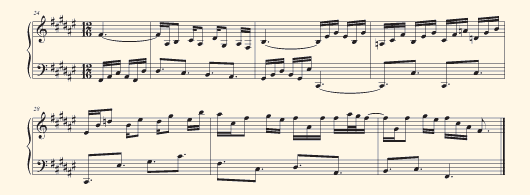
*
Before going on to the next examples, let us take note again of a feature which the first three of the preludes that we have discussed have in common when performed in the kind of unequal temperament at issue. In the first few bars of each of those preludes, the pitch-class intervals are the ones represented in the right halves of the following diagrams:


— and thus the major 3rd in the Subdominant triad is, in each of those preludes, tempered a little less than is the one in the Tonic triad, which is tempered a little less than the one in the Dominant triad, which in turn is tempered a little less than the one in the Dominant of the Dominant. These features are notable also in the E-major prelude, as we will hear presently.
All this will change, however, when we then come to some preludes with a few flats in their key-signatures and thus involving mainly the intervals represented in the left half of those diagrams. In such keys the major 3rd in the Subdominant triad is tempered a little more than in the one in the Tonic triad, which is tempered a little more than the one in the Dominant triad, which in turn is tempered a little more than the one in the Dominant of the Dominant. It is especially this latter fact (in effect: that the leading tone to the Dominant sounds slightly "lazy" or "cautious" after one has heard the leading tone to the Tonic) which seems paradoxical, since modulating from the Tonic to the Dominant, if done in a straightforward way, is inherently a moment of tonal "uplift". (And that kind of modulation is indeed done in a very straightforward way in Bars 3–5 of the G-major prelude and in the second half of Bar 3 in the A-major prelude.) We will soon see how this paradox is manifested in the A♭-major prelude, and also how the composer has evidently exploited the fact that in A♭- and B♭, the Dominant triad is tempered a bit less than the Tonic, but the Subdominant more.
But first let us consider the major-mode prelude with four sharps in its key-signature.
The E-major prelude
This piece sounds quite good in equal temperament:
Track 48: The first 3 1/2 bar, played in equal temperament.
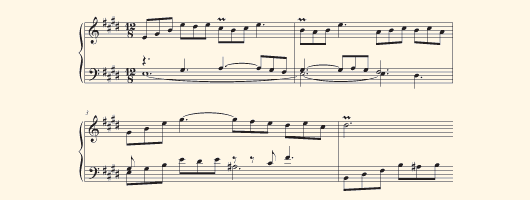
In equal temperament the qualities of the intervals would be exactly the same melodically if the music were played in F- or F♯-major as in E-major, and virtually the same with regard to the beating of the consonant intervals:
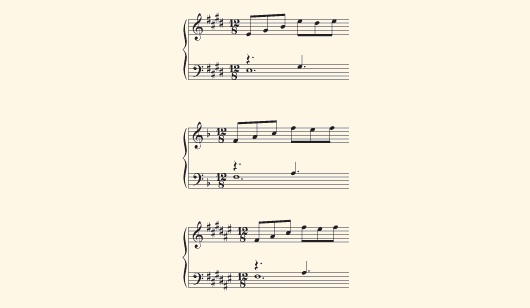
In the unequal temperament, G♯ is tuned nearly the same as in equal temperament, then D♯ slightly higher (i.e. in relation to B and E; I think this begins to become perceptible in the last beat of Bar 2), then A♯ yet higher (in relation to F♯ and B), and finally E♯ yet higher (vis a vis C♯ and F♯); but the potentially noxious effect of this remarkably high E♯ is avoided by not having, in Bars 1012, an acoustically prominent C♯-major triad:
Track 50: The first 12 1/2 bars.
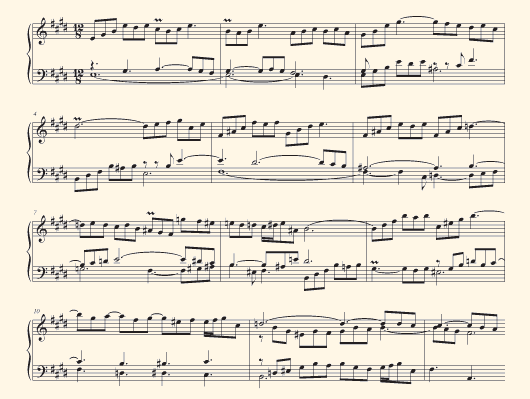
This series of successively more incisive sharps is a virtue, the value of which is then increased by the "tapering off" of incisiveness in Bars 1314 when the harmony reverts (as it were) to D♯ and then G♯, and then, best of all, to the deliciously moderate (in this context) C♯ in Bars 15-17:
Track 51: From Bar 11 through the first half of Bar 17.
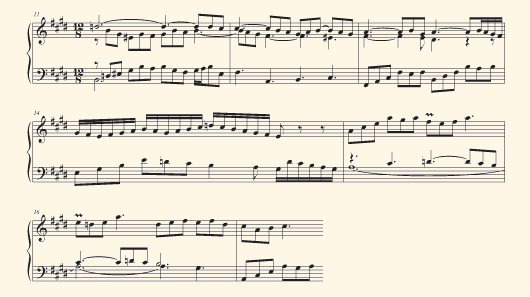
Notice how sweet it is then to regain in Bar 17 the slightly more "edged" D♯ (i.e. slightly more so in relation to E and B than is G♯ in relation to A and E):
Track 52: From Bar 14 through the first half of Bar 19.
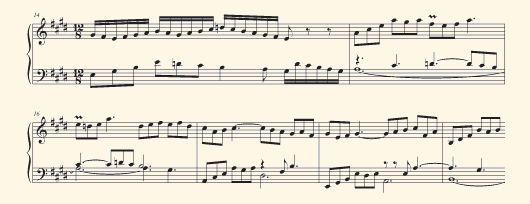
The entire quasi-Schubertian "recapitulation" (starting at Bar 15 with the statement in the Subdominant of the theme that had established the Tonic at the outset of the piece) thus gains in the unequal temperament some highlights of luminosity which enhance the inherent beauty of the harmony – including that of the plagal cadence re-evoking the gentle Subdominant in the next-to-last bar:
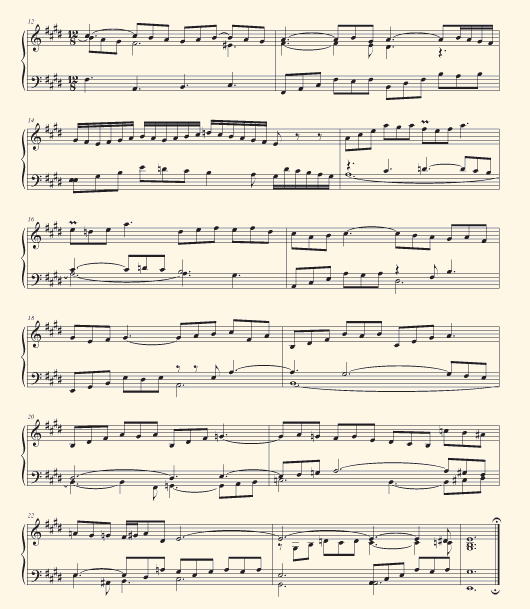
The beginning of the B♭-major prelude
The main triads in the first phrase are those on B♭, G, E♭ and F:
Track 54: The first 2 1/2 bars (plus an extra note below the range of the piece).
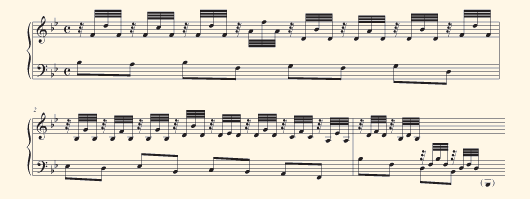
Upon hearing them as block chords, one can readily observe that the trochaic macrorhythm is enhanced by the fact that whereas the tempering of the pitch-class interval between B♭ and D is more exposed in the major 10th in the first half of Bar 1 than in the minor 6th in the second half, the E♭ triad in Bar 2 is tempered altogether more, and then the F-chord less:
Track 55: The first five main chords of the piece.

The performer can use nicely this aspect of the tuning. The "extra" bit of tempering in the E♭ triad adds a slight dose of emphasis at Bar 2 which helps (a) to keep the music driving forward and thus (b) to prevent the sequence from sounding merely academic:
Track 56: Again the first 2 1/2 bars (plus the extra low note).
(Whereas the Subdominant chord occurs here on a strong beat of the second bar, in the analogous series of chords heard in Track 6 the Subdominant chord was on the weak beat of the first bar. I would associate this difference with the fact that whereas this Subdominant triad in B♭-major is tempered more than the Tonic and Dominant, in G-major it's the other way around.)
If the music is transposed down a semitone, then the sonority of the Subdominant (D-major) triad doesn't provide that nice extra touch of forward drive:
Track 57: The same 2 1/2 bars (plus the low note) transposed down a semitone to A-major.
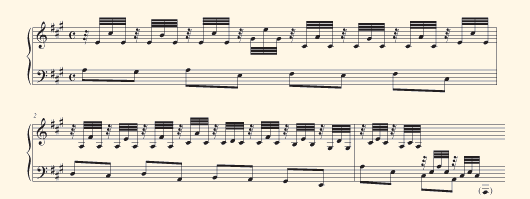
Interlude: a theme by Beethoven in A♭
This example shows that (1) if a piece in A♭-major begins with a Tonic triad including baritone's low A♭, the beating of that bass-note with C, at 5.5 per second, is like an expressively fast vibrato and is nicely shy of intermittence, and then (2) if there is soon afterwards a straightforwardly lyrical use of the leading-tone to the Dominant, then that note, D, tuned as it is lower in relation to B♭ and E♭ than C is tuned in relation to A♭ and D♭, will lead up to the E♭ in a modestly quasi-rallentando way rather than in a notably striving way:
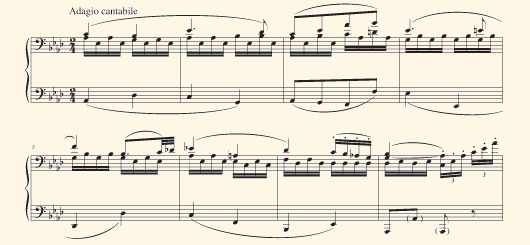
(More examples in regard to this piece are to be found in Tracks 23–29 of the CD accompanying the book, Beethoven's Opus 34. Genesis, Structure, Performance, published for the Institute by Schott in 2007.)
The A♭-major prelude
The nuances of the unequal temperament are helpful throughout this piece in one way and another.
The intermittent beating (at 11 per second) of A♭-C in the initial triad is like a slap in the face at the outset. That such was Bach's intention seems to me to be implied by the fact that the chord consists of quarter-notes rather than half-notes as one would ordinarily expect for the rhythm in question; it would have been easier and more natural to write in each bar a half-note chord followed by a quarter-note rest, rather than a quarter-note chord followed by two rests. (In the following track, notice also the unusual open-5th sonority at the beginning of Bar 5. I will refer back to this later.):
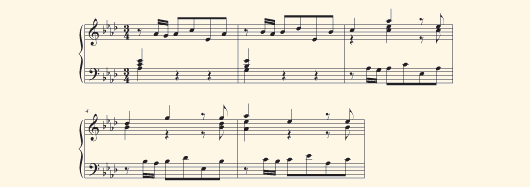
This piece is a quasi-concerto movement conceived for keyboard. But whereas Bach's "Italian Concerto" for harpsichord is in F-major and begins with a thumping big chord in the bass, in this prelude an analogous effect is due to the "slapping" quality – due in turn to the tempered tuning – of the smaller initial A♭-major chord. This fact by itself may provide sufficient explanation for why Bach wrote such piece in the key of A♭ (which he would never do in a real concerto, as it would be an unduly awkward key for the orchestral players) rather than, say, in G-major. Compare the sound of the left hand's first two chords plus an additional A♭-major chord (to make a complete mini-progression) with the sound of the same three chords transposed down a semitone to G-major:
Track 60: Three chords in A♭-major, then transposed down to G, then in A♭ again.

As in some other preludes discussed previously, the nuances of the temperament help project a trochaic macro-rhythm in the first few bars. Since the leading-tone, G, is tuned a little less high in relation to E♭ and A♭ than is C in relation to A♭ and D♭, the V-chords in Bars 2 and 4 sound a little less virile than the Tonic chords in Bars 1, 3 and 5. (This difference supports the macrorhythm implied contrapuntally as the G's in Bars 2 and 4 are mere neighbor-notes to the A♭'s in Bars 1, 3 and 5.) If the music were transposed up a semitone to A-major, the reverse would become the case: the V-chords would be tempered a little more saliently than the Tonic triads. The overall amount of "spicing" might be adequate in the A-major transposition, but to have relatively more of it in Bars 2 and 4 than in Bars 1, 3 and 5 is contrary to the trochaic macro-rhythm which can be discerned analytically at the beginning of the piece and which ought, in my opinion, to be conveyed by the performer. It is graceful.
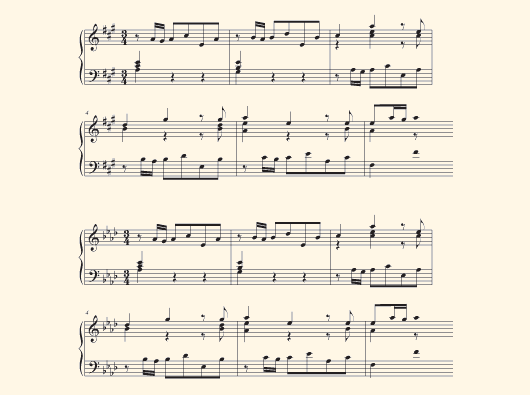
Notice that the trochaic pattern is achieved by using Tonic and Dominant chords only. The Subdominant D♭ chord, the most heavily tempered major triad in this kind of tuning, is held in reserve, as it were, for Bars 32 and 43. It seems to me that the complexity of the phrase-structure in this piece is due in part to the fact that if four-bar phrases were as prevalent here as in some of the other preludes, the backing-&-forthing between Tonic and Dominant chords would become insipid.
There is an additional possible reason for Bach to have written with quarter-notes the chords in Bars 1 and 2: to allow the right hand's notes on the second beat of each of those bars to be heard more saliently than if each chord was held over into the second beat, and thus to allow the stepwise ascent in the tune in Bars 13 from A♭ to B♭ to C to be heard clearly. (The melodic need for the C at Bar 3 explains why the A♭-major triad there is indispensable to the musical design, unlike at the beginning of Bar 5.) However, this second possible reason doesn't render the other one less likely. People often do things for two (or more) reasons at once.
Observe also that, as we have heard in a very different aesthetic context in the theme by Beethoven, the D♮ in Bars 910 makes a rather "laid back" leading-tone to the Dominant:
Track 62: The first 10 1/4 bars plus a dyad.
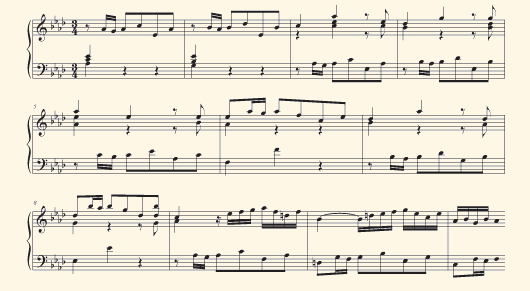
Before going on to the next examples, let me comment on some of the lineaments of the harmonic counterpoint in the first half of the piece:
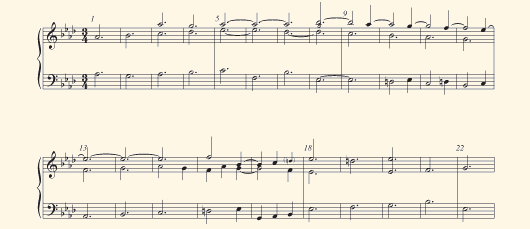
In the top line, the high A♭ which is arrived at in Bars 56 is not pulled down to G by the B♭ in the harmony in Bar 7. (One of Bach's pupils, Kirnberger, in his copy of the piece evidently changed the high A♭ in Bar 7 to a G. The logic for that "correction" is obvious, but I think it weakens the music.) Instead, the contrapuntal obligation to resolve down to G is deputized to the lower A♭ at the end of Bar 7, whereas the high A♭ is succeeded in Bar 8 by a B♭ which initiates a line going down stepwise to the E♭ in Bar 13 (and ultimately 18). It is during the descending sequence in Bars 912 that the modulation to the Dominant is signaled by the uses of D♮ instead of D♭; so, there is no need for the tuning to make salient the fact that this new leading tone will presently lead upwards to the Dominant; it can perfectly well be slightly "lazy," and indeed this aspect of it fits well the immediate context of the descending sequence. But then there is an ascending sequence in Bars 13–15. The Bach-style tuning helps make salient the fact that the pivot between the two sequences is the dyad at the beginning of Bar 13, as that dyad is one of the most strongly tempered major 6ths (here a compund major 6th) in this kind of unequal temperament:
Track 63: From Bar 6 to the beginning of Bar 19.
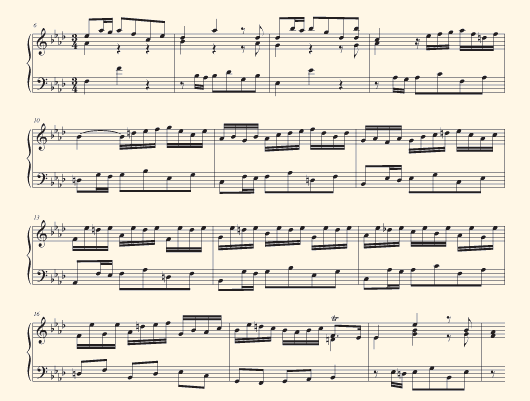
(In my opinion, the only major 6th or minor 3rd which should be tempered more than one between F and A♭ is the one between D♭ and B♭, and indeed it is this latter kind of interval which will at Bar 30 serve the same kind of pivotal function in the second half of the piece, i.e. in the analogous modulation from the briefly evoked Subdominant at Bar 26 to the Tonic at Bar 35.)
When the music is transposed up a semitone, then in Bar 9 the leading-tone (D♯) to the Dominant sounds a little more edgy than does C♯ in the Tonic triad (because D♯ is tempered more vis a vis B than is C♯ vis a vis A), and then at Bar 13 the pivotal major 6th, A-F♯, sounds banal because it is tempered in an inadequately incisive way for its function at that point in the music:
Track 64: Bars 6–14 transposed up a semitone.
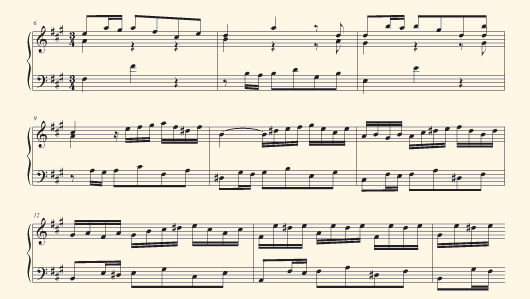
Here is the same comparison in reverse, i.e. first the transposed version and then the notes that Bach actually wrote:
Track 65: Bars 6–14 transposed up a semitone and then Bars 6-22 not transposed.

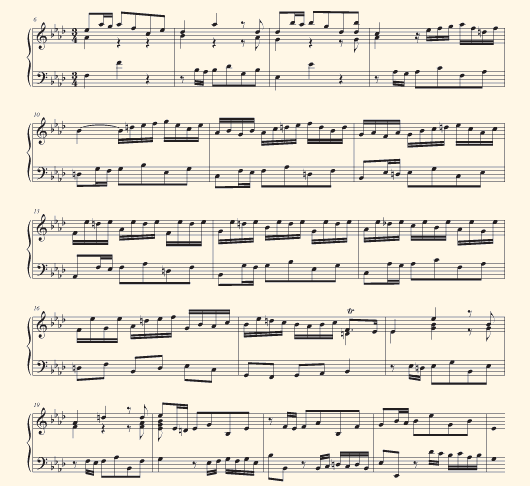
Notice that whereas the rather unusual use of an open-5th sonority on the downbeat at Bar 5 had avoided a repetition of the "shocking" effect of the initial downbeat-A♭-major triad, the analogous sonority at Bar 20 is a complete E♭-major triad.
Before going on to a few examples from the end of this piece, let us consider the following description of its overall tonal design:
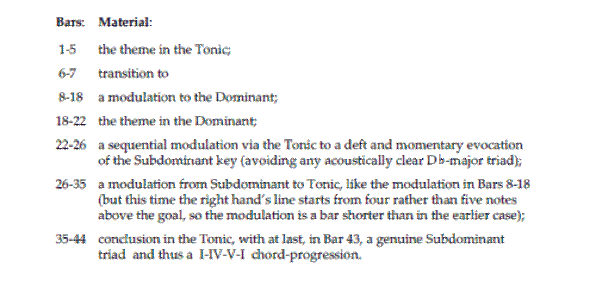
This description shows (among other things) that the Subdominant triad in the next-to-last bar is important in the overall tonal design of the piece.
In Bars 39–42 the trochaic macrorhythm of the first few bars is evoked, and meanwhile the flurry of constant 16th-notes for both hands in Bars 3940 helps set a context of vigor for the very heavily tempered - and therefore itself suitably vigorous - D♭-major triad in the next-to-last bar:
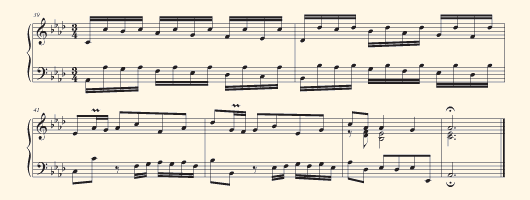
When this material is transposed up a semitone to A-major, the Subdominant triad becomes slightly stodgy and "academic" – not the right kind of sound for this moment in this piece:
Track 67: The last 4 bars transposed up to A-major.

Here is the comparison in reverse:
Track 68: The last two bars transposed up a semitone and then not transposed.
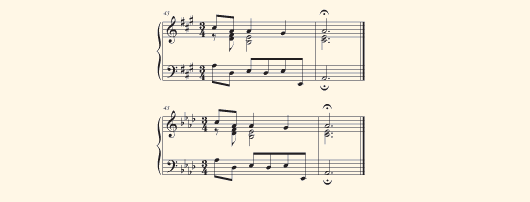
*
Please note, in the following reading of the whole A♭-major prelude, that (a) the D♮'s in Bars 9 and 11 sound "gentler" (because of their modest tempering) than the dyad at the beginning of Bar 13, and the modest tempering of the D♮ in Bar 19 helps give to that bar a macro-rhythmically weak character vis a vis Bars 18 and 20; (b) in Bar 22 the low intonation of the D♭ helps give a sense of impetus to the modulation back from E♭- to A♭-major (and that impetus is beneficial here in the middle of the piece as the harmony is about to move on into Subdominant territory), and then (c) the low intonation of the D♭'s in Bars 2633 help to project a trochaic macro-rhythm whereby Bars 26, 28, 30 and 32 are stronger than 27, 29, 31 and 33.
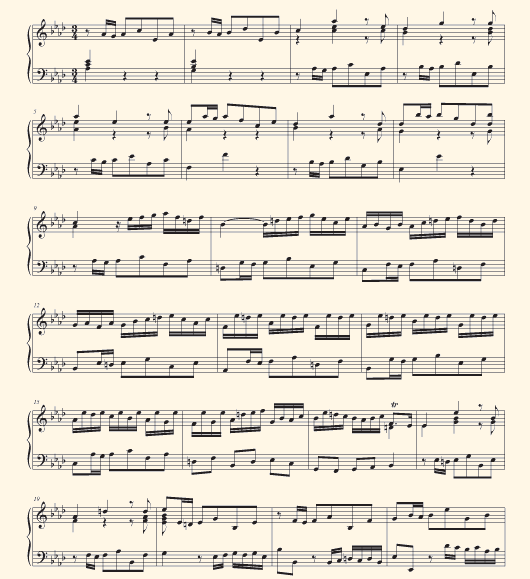
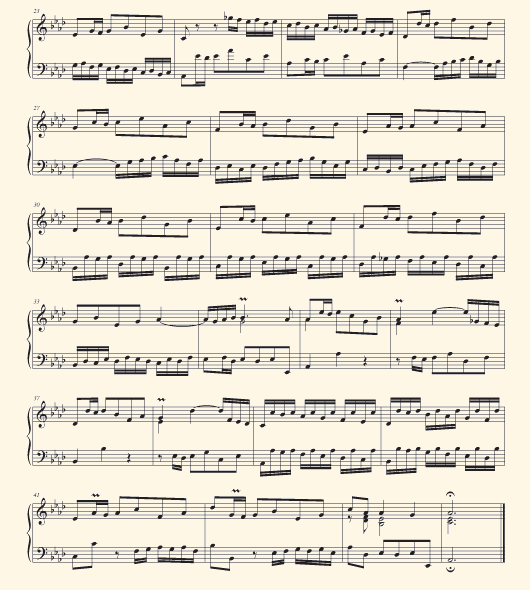
I have dwelt upon this piece because my ideas about interpreting it in performance are rather different from those of Hans Bischoff (in his invaluable edition of the '48') and of many other pianists who have played it only in Equal Temperarment and never in the style of tuning which I think Bach in the early 1720s liked more than he did Equal Temperament. I agree that the tempo should be Allegretto or moderately Allegro, but not that the overall character should be dolce. I think that most of the notes should be played sciolto, and that the tradition of playing the piece legato and calm is due to the fact that pianists have been ignorant of the nuances of temperament discussed here and have been influenced instead by the general history of A♭-major as a key hosting tender rather than vigorous affects. Bach would indeed readily compose tender pieces in E♭-major (some illustrations of such tender music in a Bach-style unequal temperament are available in the Webpage of examples of organ music), but we have seen also that for the major key a semitone above that of C♮, he favored a vigorously frolicsome rather than a tender prelude and he wrote it in C♯- rather than in D♭-major. One reason may perhaps have been that he felt that the "prickly" look of sharps and double-sharps would be better suited to the character of the piece than the look of flats. In any case he was willing to have for that piece a key signature of seven sharps rather than of five flats. However, to notate the A♭-major prelude (and/or the fugue) in G♯-major instead of A♭ would have been out of the question as it would have entailed having a double-sharp in the key-signature; so, I think one shouldn't be deterred by the sight of those flat-signs from adopting the more interesting, virile interpretation – especially since it is supported by the nuances of an historically correct style of tuning – rather than the less interesting dolce interpretation.
Again: I do not claim that my playing is extremely good (I am not a professional performer), but only that my ideas as explained here are well founded.
An ancillary reason for discussing this piece and the E-major prelude is that one of the main differences between Bradley Lehman's scheme and my concept of Bach-style unequal temperament is that he tempers A♭-C significantly less than E-G♯ whereas I think it should be the other way around. The musical value and interest of the heavily tempered A♭'s seem to me quite clear in this piece and very clear in some of the examples in the Webpage of organ music.
Let us consider now some of the preludes in minor keys.
The C-minor prelude
Most pianists treat this as an etude in fleeting finger-technique. The aesthetic effect of a mechanical rendering in equal temperament is akin to that of an insensitive pianist's performance in the nuanced temperament.
Track 70: Bars 1–5 rendered in equal temperament by a midi-synthesizer.
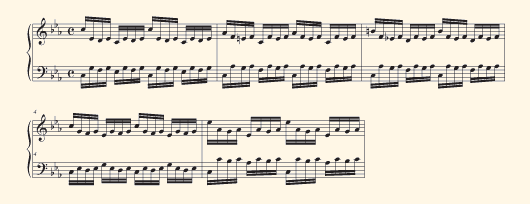
Track 71: Bars 1–5 played fast (by a pianist) in the unequal temperament.
However, in the unequal temperament the dark E♭'s and A♭'s and the rather dull leading-tone (B) support the view that Glenn Gould's and Wanda Landowska's concepts of how to play this piece were correct. It is indeed a toccata, but it should not be played veloce at the outset; it should start big and heavy (like Bach himself), and probably not faster than this:
Track 72: Bars 1–6 played rather slow.
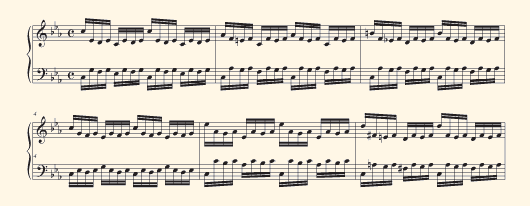
When this same material is heard transposed up (in the unequal temperament) to D-minor, the third and sixth degrees of the scale and the leading-tone sound inherently less expressive and more nondescript and are therefore less able to sustain interest at a slow tempo. The following track stops at the beginning of Bar 5 in order to bring out how unexpressive (and thus inadequate to the moment) is the right hand's high F there:
Track 73: The first 5 bars plus a dyad, transposed up a whole-tone to D-minor.
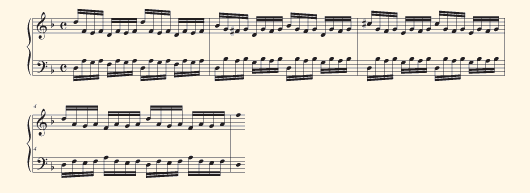
You may recall the "curiously insipid effect" and the "insufficiently aggressive" sound of the C-major triads at the end of transposed versions of the B- and C♯-major preludes. Those unsatisfactory results were due to the mildly vibrato-like quality of the of the major 3rd C-E beating at 3 per second. At the end of this prelude, however, the same kind of beating in the major 10th between tenor's low C and middle E is appropriately expressive:
Track 74: The last 1 1/2 bars.

When this material is transposed up a whole-tone to D-minor, the beating of the final F♯ at about more than 4 per second, though by no means ugly, seems nonetheless ill-at-ease when compared to that of C-E in the untransposed version. Notice also how in Bar 36 the D♭ in the music as Bach composed it sounds inherently more expressive than the corresponding E♭ in the transposition; this is of course related to the fact that D♭-C is a slightly smaller semitone than E♭-D:
Track 75: The last 4 bars transposed up a whole-tone, then untransposed.
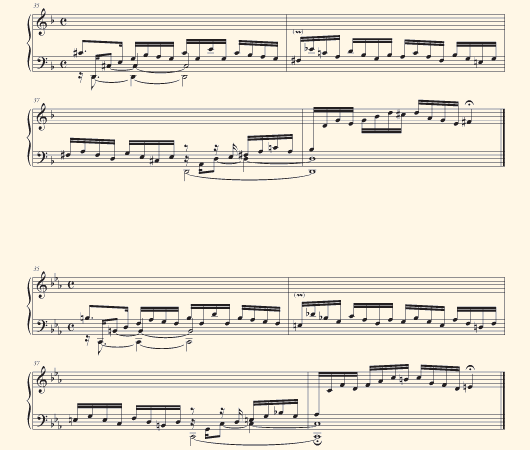
The D-minor prelude
This piece begins in an almost happy, "flowing" mood (and later builds up to a strong conclusion):
Track 76: The first 1 1/4 bars.

When this beginning is transposed down a whole-tone to C-minor, the resulting E♭ and A♭ sound inherently darker than their counterparts (F and B♭) in D-minor, since E♭ and A♭ are tuned lower in relation to C and G than are F and B♭ in relation to D and A:
Track 77: The first 1 1/4 bars transposed down a whole-tone to C-minor.

I think the transposed version would be more suitably performed in a more sombre tempo:
Track 78: The same transposed 1 1/4 bars played slower.
In the untransposed version, the mood of happy flowing is then confirmed by dwelling on the relative major key for several bars, and is helped by the mild tempering of the F-major triad:
Track 79: From the beginning until the first part of Bar 6.
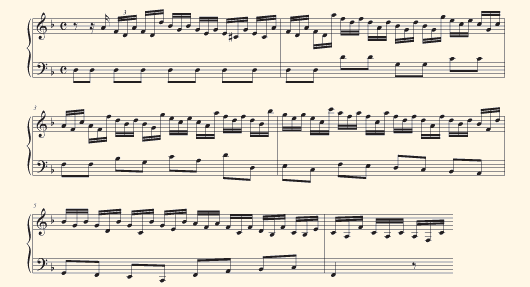
When the music is transposed down a whole-tone, the relative major sounds less euphonious because the beating of middle G with middle E♭ is intermittent (at more than 7 per second):
Track 80: From the second half of Bar 1 to the beginning of Bar 3, transposed down a whole-tone.

Listen again to the last part of that transposed version:
Track 81: The last beat of Bar 2 and first beat of Bar 3, transposed down a whole-tone.

The transition from the fairly calm mood of the beginning of the piece to a more extraverted one at the end of it begins with the modulations in Bars 69. F♯ as the leading-tone to G is introduced in Bars 67 (along with E♭ as the sixth degree of G-minor) and then in Bars 89 G♯ as the leading-tone to A - and this new leading-note is more incisive as such than F♯ has been in relation to G, partly because G♯-A is a smaller semitone than F♯-G (though partly also, of course, because of the stepwise-ascending sequence):
Track 82: From Bar 6 to the beginning of Bar 10.
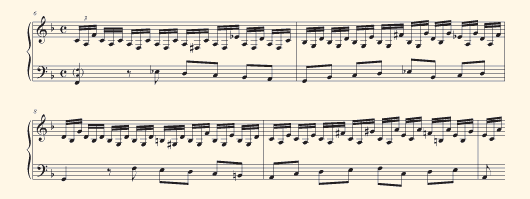
The amount of tempering in the D-major chord at the end of the piece is enough to sound suitably "alive" (not too pure), but not so much as to sound nervous or shrill:
Track 83: The last 2 1/2 bars (plus three notes before).

When the same material is transposed down a whole-tone, the new last chord sounds curiously insipid because the tempering of the major 3rd C-E is too tepid for this particular context:
Track 84: The last 2 1/2 bars (plus the three preceding notes) transposed down a whole-tone.

Here is the comparison more succinctly:
Track 85: The last four chords and then the same chords transposed down a whole-tone.
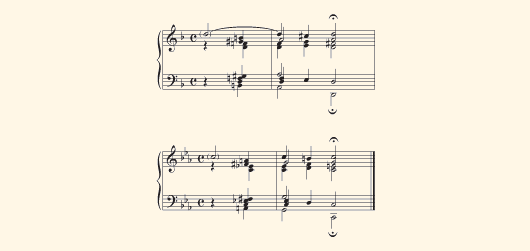
The F-minor prelude
This key is notable, in terms of tuning nuances, for the extent to which the Tonic triad is heavily tempered, the leading tone is droopingly lazy, and the semitone between the fifth and sixth degrees of the scale is remarkably small. These nuances are (in my opinion) largely accountable for the fact that F-minor has been traditionally described as "melancholic":
Track 86: The first 3 bars plus a dyad.
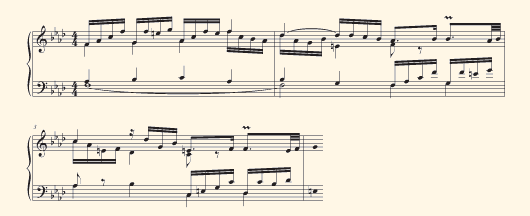
If this piece were transposed down a semitone to E-minor, the resulting high leading-tone might be considered expressive in a certain edgy way, but still there would be net loss of expressivity already in Bar 1 because of the very moderate tempering of the Tonic triad (and then later also because of the large semitone between the fifth and sixth degrees of the scale):
Track 87: Bar 1 transposed down a semitone to E-minor.

Looking ahead now: F-G♮ as a melodic whole-step is featured, thematically, not only in the first half of Bar 1 but also again in the second half Bar 2, and therefore the melodic semitone F-G♭ in Bar 4 will be even more "surprising" than the C-D♭ in Bar 3. The surprise would be there in any reasonably presentable tuning, but is especially pleasing in this kind of temperament because of the remarkably small size of F-G♭ and because the small semitone sounds all the more sneaky down in the bass.
And then when the harmony finds its way at Bar 6 to the relative major A♭-major the bass line walks up an octave (in Bars 68), and here the lavish tempering of the 3rds in the Tonic and Subdominant triads can be exploited to project a luminosity complementing the pathos of the sections in F-minor between which this section is nested:
Track 88: From the middle of Bar 2 to the last beat of Bar 12.
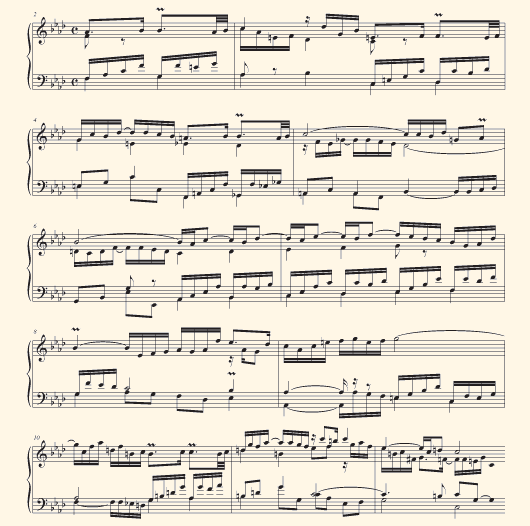
It would be something of a waste to perform such music academically "straight":
Track 89: The first 2 1/4 bars played faster.

(Some pianists play Chopin with as much rubato as their sense of the music prompts them to make, but feel that avoiding rubato (except at the end of a movement) is essential to achieving "Bach style." However, since the harpsichord and organ provide far less opportunity for dynamic nuance than the piano does, intelligent use of rubato is an important expressive device for performers of instrumental compositions on those instruments.)
The beginning of the B♭-minor prelude
In this key the Tonic and Subdominant triads are tempered even more darkly than their counterparts in F-minor; and, the leading-tone, though not quite as droopy as the one in F-minor, is still notably lazy. These qualities can be well exploited in the opening bars of this prelude:

Even if the leading-tone is played louder halfway through Bar 2, it will still droop. And then halfway through Bar 4 the piercing smallness of the left hand's harmonic semitone F-G♭ seems to help impel the tune up to high C (the top note on keyboard instruments used routinely by Bach):
Track 91: To the beginning of Bar 5.
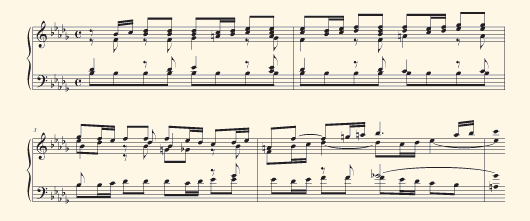
When this material is transposed down a semitone to A-minor, the resulting C's and F's are less expressive than the original D♭'s and G♭'s:
Track 92: Those same bars transposed down to A-minor.
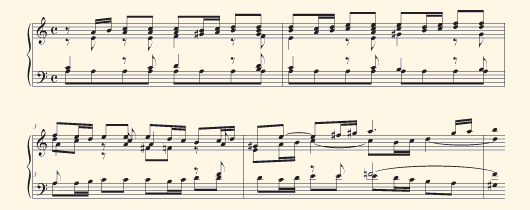
The greater poignancy of the chord halfway through Bar 4 in the original key than in the transposition is due to a combination of facts: (1) F-G♭ is some 15% smaller than E-F, and (2) in the A-minor version, F-A is tempered by only about 2/3 as much as is E-G♯, whereas (3) in the B♭-minor version, G♭-B♭ is tempered by nearly twice as much as is F-A:
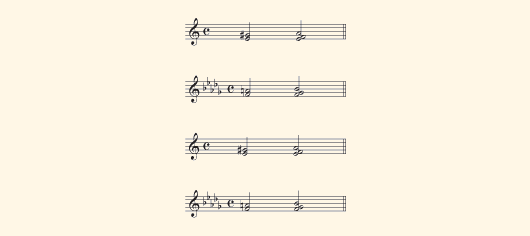
The A-minor prelude
This is not a sad piece. The right hand's first three notes could make a sad motif, but should not be so interpreted. A correct (i.e. not sad) interpretation is served by the fact that the third degree of the A-minor scale is tempered very moderately (i.e. not very low). Also well suited to the context of this theme are (1) the somewhat but not very high leading note – high enough to be strong, but not so high as to be tenderly "yearning," and (2) the rather high and therefore not pathos-laden F♮ (which in the tune in Bar 3 does not go down to E but directly up to the leading-tone):
Track 94: The first nearly 3 1/2 bars.
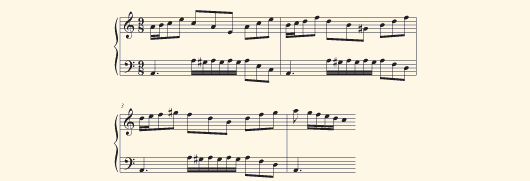
When transposing the theme up a semitone up to B♭-minor, I sense a different mood already with the D♭ in Bar 1 (morose-sounding, because it is tempered so low); and this feeling is sustained by the pathetically "lazy" sound of the right hand's A's in Bar 3.
Track 95: The same material transposed up a semitone.
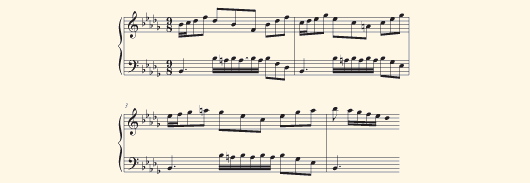
In Bars 5–8 the fact that D♯-E is a smaller semitone than G♯-A, and then A♯-B yet smaller, serves to help give the key of E-minor an "icy" but not sad aura, appropriate to the rhetorical context. Then, after a "tapering off" (from such acutely tuned semitones) in the descending sequence with its F♯-G and C♯-D in Bar 9 and E-F in Bar 10, the music begins in Bar 11 to revel for six bars in the warmth of the moderately tempered key of C-major (the relative major of A-minor):
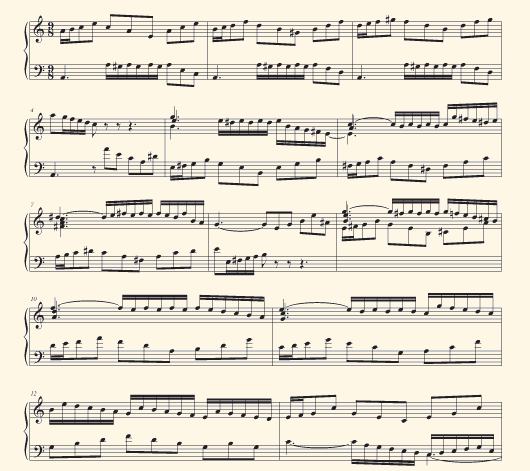
The warmth is due is part to the fact that C-major has been approached from E-minor and by a descending sequence (rather than by a sequence ascending from A-minor). But still, the substantial role (in creating this effect of warmth in C-major) of the tuning nuances can be demonstrated by hearing the modulation from E- minor to C-major performed without those nuances:
Track 97: Bars 9–14 in equal temperament, then Bars 7–16 in the unequal temperament.
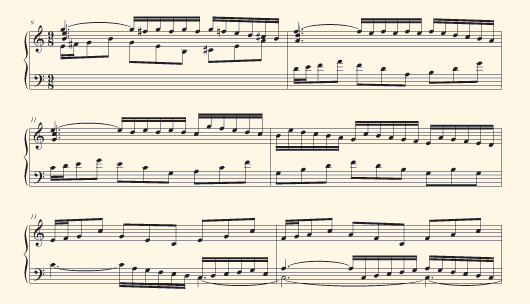
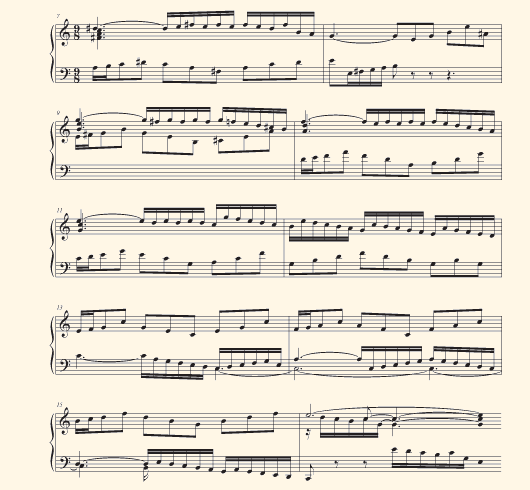
If the modulation to C-major is transposed up a semitone so that it becomes a modulation to D♭-major instead, here is how it sounds:
Track 98: Bars 911 and the first dyad of Bar 12, transposed up a semitone.
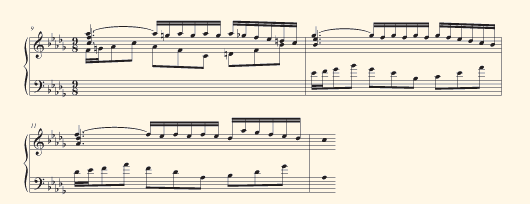
The section in C begins and ends with alto's high E in the top line (at Bars 11 and 16), and within that section the right hand's statement of the I-IV-V-I thematic material starts (at Bar 13) with middle E. This pitch-class is not only inherently the most "tuneful" member of the C-minor triad but also the overarching link between the intermediate key of C-major and main key of A-minor. However, the harmonic path back to A-minor involves in Bars 17–22 a succession of three diminished-7th chords, each with a leading-note that is slightly more incisive than the immediately preceding one. (That is, F♯-G in Bars 1718 is a smaller semitone than B-C in Bars 1516; then C♯-D in Bars 1920 is slightly smaller than F♯-G; and then G♯-A in Bars 21–23, and ultimately 27–28, yet smaller.)
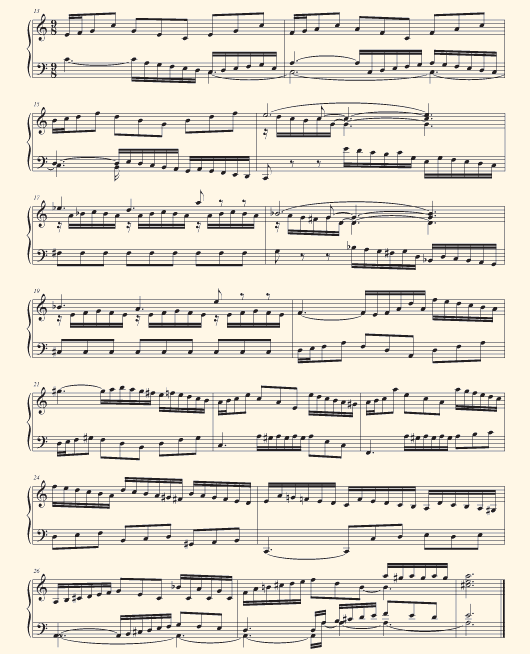
The nuances of the tuning thus make the whole piece sound interesting and graceful.
As a kind of postscript I would like to add the following remarks (having nothing to do with nuances of tuning) putting into a broader analytical context my comment about F♯, C♯ and G♯ in Bars 1721:
A feature of the right-hand part in Bars 14 is the stepwise ascent from E in Bar 1 to F in Bar 2, G♯ in Bar 3 and then A in Bar 4. Notice, by the way, that the same set of pitch-classes which make a Subdominant chord in Bar 2 make a Dominant chord in Bar 3 (with the left hand's A acting as a pedal-point). This is a witty exploitation the fact that one of the four steps up in the right-hand part is the augmented 2nd from F to G♯.
There is an ensuing stepwise descent in Bars 58, with the G♮ in Bar 5, the F♯'s in Bar 7, and the E in the last beat of Bar 8 and another such descent in Bars 911, but this time with F♮ (rather than F♯) in Bar 10.
The E in Bar 11 recurs at Bar 16 still supported by C in the bass but now hinting implicitly one might almost say "shouting implicitly" that the music is about to return to A-minor. (A nice detail is that the right-hand part in Bar 15 is exactly the same as in Bar 2 except for the difference between G♯ and G♮; the harmony must now somehow restore G♯ as the leading-tone to A.) But the return to A-minor is attenuated until Bar 21. While the F♯ at Bar 17 serves as a leading-tone to the G at Bar 18, and then the ensuing C♯ as a leading-tone to the D at Bar 20, there is, in the right-hand part, a stepwise descent from the E at Bar 16 to the middle F a Bar 20: this is a matter of E♭ and D and the last of the three C's in Bar 10, and then B♭ and A and the last of the G's in Bar 19. The middle F thus reached the beginning of Bar 20 is then replicated an octave higher (and thus a step up from the E in Bar 16) on the last beat of that bar, and then the ensuing G♯ evokes the ascending augmented 2nd of Bar 3.

